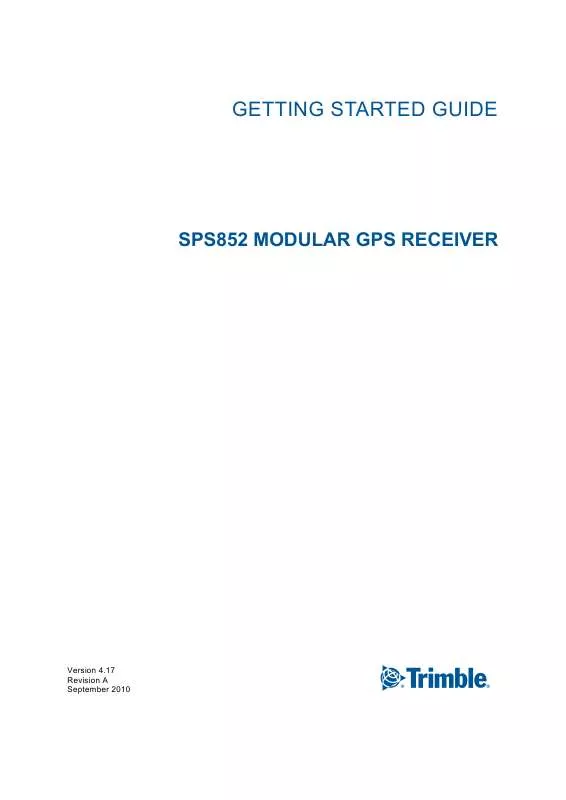Detailed instructions for use are in the User's Guide.
[. . . ] GETTING STARTED GUIDE
SPS852 MODULAR GPS RECEIVER
Version 4. 17 Revision A September 2010
F
Legal Notices
Corporate Office Trimble Navigation Limited 935 Stewart Drive Sunnyvale, CA 94085 USA www. trimble. com E-mail: trimble_support@trimble. com Heavy Highway business area Trimble Navigation Limited Heavy Highway business area 5475 Kellenburger Road Dayton, Ohio 45424-1099 USA 800-538-7800 (toll free in USA) +1-937-245-5600 Phone +1-937-233-9004 Fax www. trimble. com Legal Notices © 20062010, Trimble Navigation Limited. Trimble, the Globe & Triangle logo, and TSC2 are trademarks of Trimble Navigation Limited, registered in the United States and in other countries. AutoBase, CMR, CMR+, EVEREST, HYDROpro, Maxwell, Micro-Centered, Trimble Geomatics Office, SiteNet, TRIMMARK, TRIMTALK, TSCe, VRS, Zephyr, and Zephyr Geodetic are trademarks of Trimble Navigation Limited. The Bluetooth word mark and logos are owned by the Bluetooth SIG, Inc. [. . . ] The status screens provide the following information: · Position solution and precisions · CMR and RTCM IDs or OmniSTAR satellite and link status · Base name and code · Latitude, longitude, and height · Antenna height · Horizontal and vertical precision · Receiver model and hardware version · Receiver firmware version · Receiver serial number · Receiver IP address To access these screens from the Home screen, press or .
Radio status When a radio is installed (either 450 MHz or 900 MHz), the following status messages appear at the top line of the screen:
Message Tran Recv Busy Sync Rept Sig Ovld Description Transmitted a frame Received a frame Frame was blocked Got sync with base station Repeated a frame Got carrier detect Radio bandwidth exceeded (data has probably been lost)
SPS852 Modular GPS Receivers Getting Started Guide
17
Quick Screen Guide
18
SPS852 Modular GPS Receivers Getting Started Guide
SPS852 Modular GPS Receivers Getting Started Guide
19
20
SPS852 Modular GPS Receivers Getting Started Guide
Configuring System Settings
You can use the keypad and display of the receiver to configure the following settings: · Display language · Display and input units · Baud rate, parity, data bits, and stop bits for serial ports · Display power saver · AutoBase warning · Set position precisions To access the system settings: . Use the Operation Mode screen to configure 1. In the Home screen, press system settings or mode settings, and to view the SV (satellite) status. When the operation mode begins to flash, the receiver is in Edit mode and you can change this setting. Use the Display Language screen, if required, to change the language. Choose English, Finnish, French, German, Italian, Spanish, or Swedish. Use the Display and Input Units screen, if required, to change the units to Meters or US Feet. Use the Port Settings screen, if required, to change the port. Use the Screen Pwr Savr screen to choose On, Off, or Auto. If you use the Auto setting, the screen turns off after 60 seconds of inactivity. The Power LED remains lit so that you can tell if the receiver is on or off. If an error message appears, the screen comes back on. Press to accept the change and again to move to the next screen. If you are using an SPS Modular GPS RTK base station, the Autobase warning screen appears. See Automatically Setting up a Mobile Base Station Using AutoBase Technology. Press to accept the change.
SPS852 Modular GPS Receivers Getting Started Guide
21
14. When the Home screen appears, the system setup is complete.
Turning off AutoBase technology To turn off AutoBase technology, use either the receiver's keypad and display or the web interface (see Receiver Configuration menu). When AutoBase technology is off, you can establish a new base station position in the receiver using the Edit Current or New Base (Here) menus. This does not automatically generate a new application file, but changes the settings in the current application file. When the receiver is turned on again, the most recent settings are always used. To turn off AutoBase technology using the receiver: 1. When the operation mode begins to flash, the receiver is in Edit mode and you can change this setting. [. . . ] Corrections and additional information are broadcast using geostationary satellites. The signal strength of a satellite is a measure of the information content of the signal, relative to the signal's noise. The typical SNR of a satellite at 30° elevation is between 47 and 50 dBHz. The satellite skyplot confirms reception of a differentially corrected GPS signal and displays the number of satellites tracked by the GPS receiver, as well as their relative positions. [. . . ]


